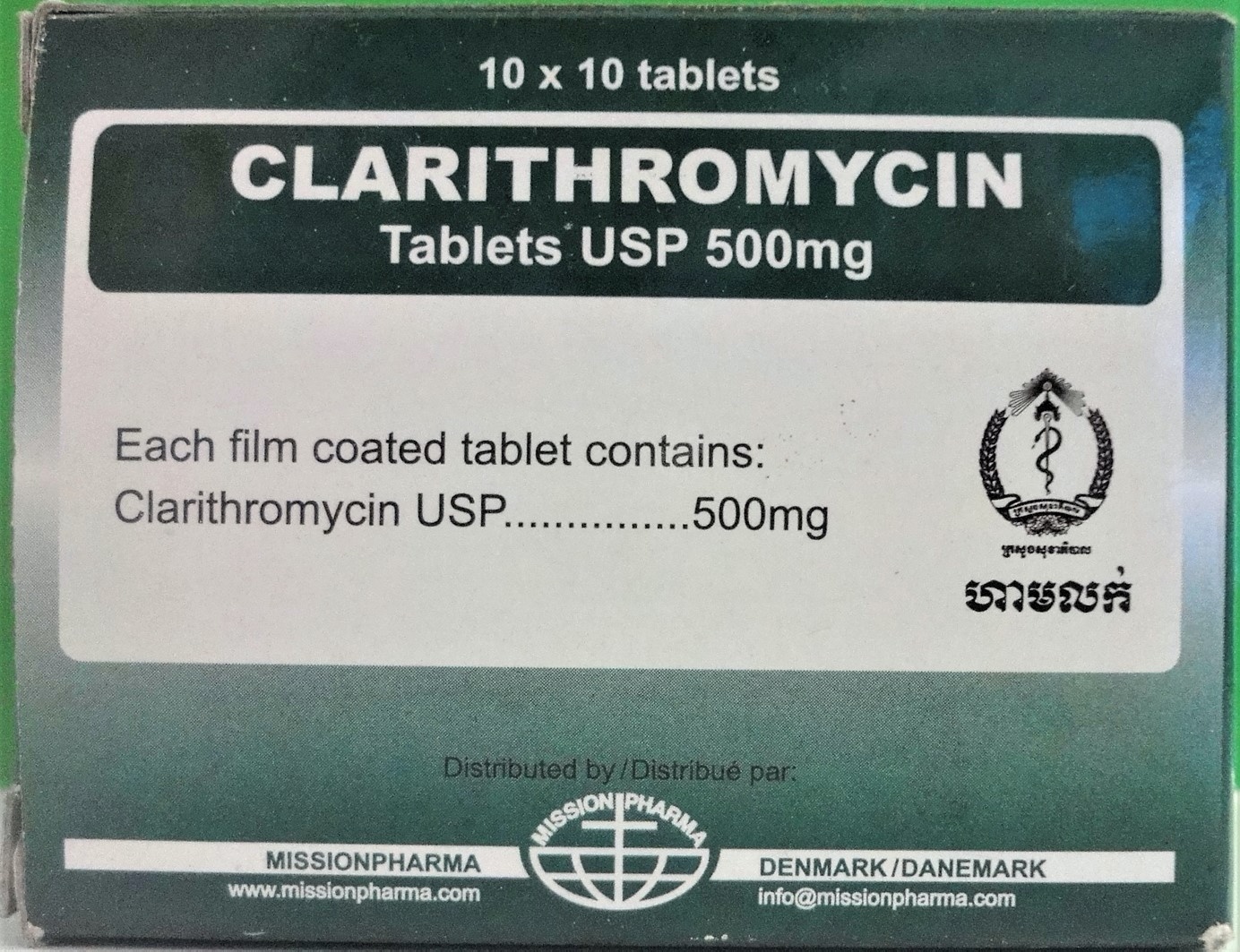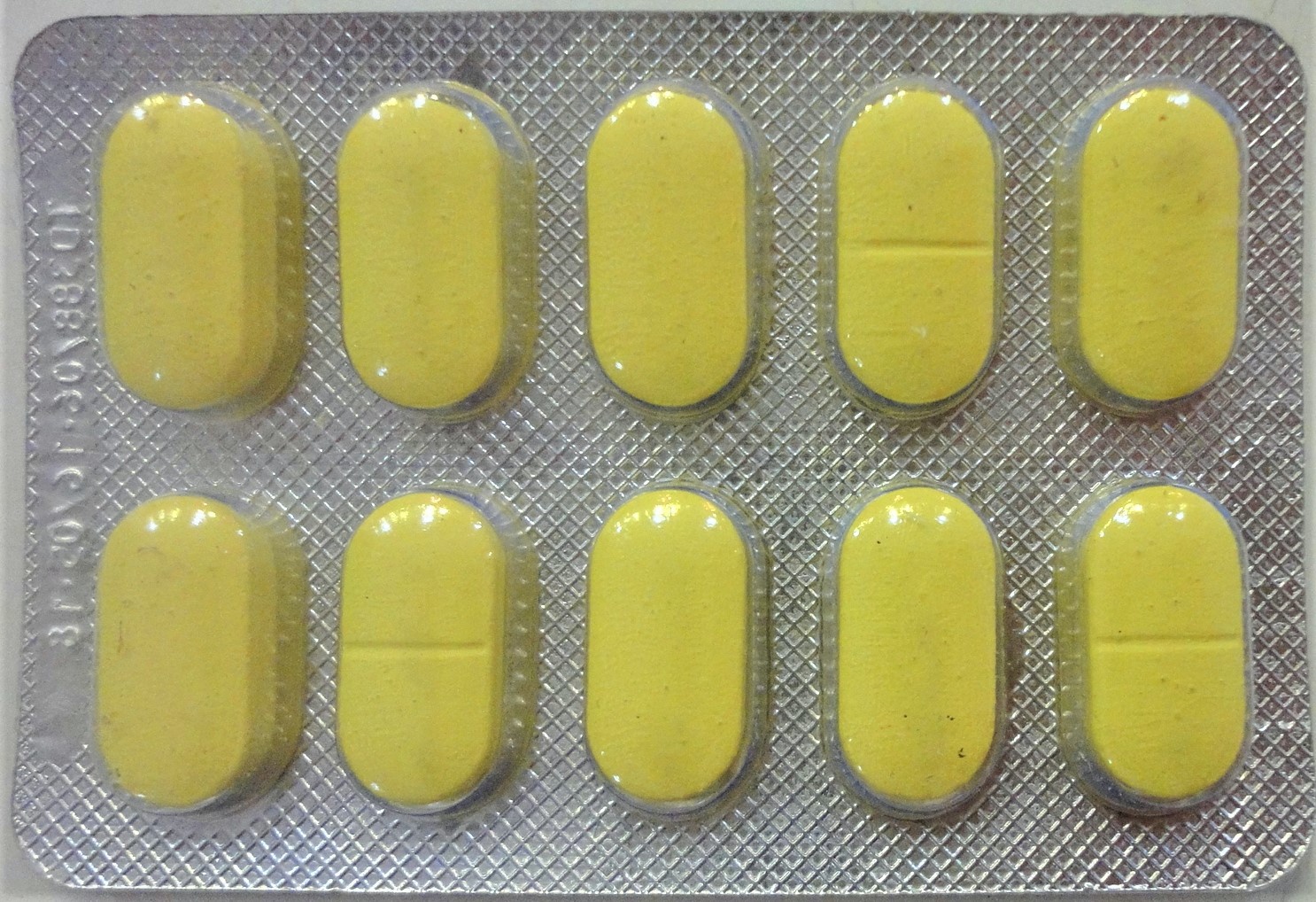CLARITHROMYCIN USP Tablet
ក្រុមហ៊ុនផលិតឱសថ:
Fabrique par, India


- សារធាតុសកម្ម
- ប្រសិទ្ធិភាពព្យាបាល និង កម្រិតប្រើប្រាស់
- ហាមប្រើ
- ផលរំខាន
- អន្តរប្រតិកម្ម
- ស្ត្រីមានផ្ទៃពោះ និង ស្ត្រីបំបៅដោះកូន
- ការប្រុងប្រយ័ត្នជាពិសេស បរិយាយប័ណ្ណឱសថ
-
សារធាតុសកម្ម
Clarithromycin 500mg
-
ប្រសិទ្ធិភាពព្យាបាល និង កម្រិតប្រើប្រាស់
In adults and adolescents 12 years and older for the treatment of the following bacterial infections, when caused by clarithromycin-susceptible bacteria:
- Acute bacterial exacerbation of chronic bronchitis
- Mild to moderated community acquired pneumonia.
- Acute bacterial sinusitis
- Bacterial pharyngitis
- Skin infections and soft tissue of mild to moderate severity, such as folliculitis, cellulitis and erysipelas.
Dosage and Administration
Route of administration: Oral
Children older than 12 years and adults:
- Standard dosage: The usual dose is 250mg twice daily.
- High dosage treatment (severe infections): The usual dose may be increased to 500mg twice daily in severe infections.
Children under 12 years of age should use clarithromycin paediatric suspension.
Dosage in renal functional impairment:
The maximum recommended dosage should be reduced proportionately to renal impairment. In patients with renal impairment with creatinine clearance less than 30mL/min, the dosage of clarithromycin should be reduced by one-half, i.e. 250mg once daily, or 250mg twice daily in more severe infections. Treatment should not be continued beyond14 days in these patients.
Duration of therapy
The usual duration of treatment is 6-14 days. In streptococcus pyogenes (as a beta-haemolytic streptococcal) infections the duration of therapy should be at least 10 days.
-
ហាមប្រើ
- Clarithromycin is contra-indicated in patients with known hypersensitivity to clarithromycin, to any other macrolide antibiotics, or to any of the excipients.
- In patients with serious hepatic failure.
- Clarithromycin and ergot derivatives should not be co-administered.
- Concomitant administration of clarithromycin and any of the following active substances is contraindicated: cisapride, pimozide and terfenadine. Elevated cisapride, pimozide and terfenadine levels have been reported in patients receiving either of these active substances and clarithromycin concomitantly. This may result in QT prolongation and cardiac arrhythmias including ventricular tachycardia, ventricular fibrillation and Torsade de Pointes.
- Concomitant administration with simvastatin.
- Clarithromycin should not be administered to hypokalaemia patients (risk of prolongation of QT-time).
-
ផលរំខាន
The most frequently reported events in adults taking clarithromycin are diarrhoea, nausea, abnormal taste, dyspepsia, abdominal pain/discomfort and headache.
-
អន្តរប្រតិកម្ម
See the package insert about the details.
Cisapride, pimozide, terfenadine and astemizole
Concomitant administration of clarithromycin and any of these medicinal products is contraindicated:
Ergotamine/dihydroergatamine
Strong inhibitors of CYP3A4
Antimycotics of the azole class (fluconazole, itraconazole, ketoconazole)
-
ស្ត្រីមានផ្ទៃពោះ និង ស្ត្រីបំបៅដោះកូន
Data from animal studies have shown reproductive toxicity. The risk of humans is unknown. Clarithromycin should only be used during pregnancy after a careful benefit/risk assessment. Clarithromycin and its active metabolite are excreted in breast milk. Therefore, diarrhoea and fungus infection of the mucous membranes could occur in the breast-fed infant. The benefit of treatment of the mother should be weighed against the potential risk for the infant.
-
ការប្រុងប្រយ័ត្នជាពិសេស
- Clarithromycin should be reserved for documented Group A beta-hemolytic streptococcal pharyngitis when treatment with beta-lactams cannot be used.
- Clarithromycin is mainly excreted by the liver. Therefore, clarithromycin should be administered with caution in patients with impaired hepatic function, especially in patients with impaired renal function.
- When renal function is poor, dosage of clarithromycin should be suitably reduced depending on the degree of the impairment. In elderly patients, the possibility of renal impairment should be considered.
- Patients who are hypersensitive to lincomycin or clindamycin may also be hypersensitive to clarithromycin. Therefore, caution is required when prescribing clarithromycin for such patients.
- Prolonged or repeated use of clarithromycin may result in an overgrowth of non-susceptible bacteria or fungi. If super-infection occurs, clarithromycin should be discontinued and appropriate therapy instituted.
- Attention should be paid to the possibility of cross resistance between clarithromycin and other macrolide drugs, as well as lincomycin and clindamycin.
- Pseudomembranous colitis has been reported with the use of broad-spectrum antibiotics. Therefore, it is important to consider its diagnosis in patients who develop severe diarrhoea during or after therapy with clarithromycin.
- As known for other macrolides, clarithromycin may cause exacerbation or aggravation of myasthenia gravis and should therefore be used with caution in patients with myasthenia gravis.
- Due to a risk of prolonged QT-interval, clarithromycin should be used with caution in patients with a coronary vessel disease, a history of ventricular arrhythmia, severe cardiac insufficiency, non-compensated hypokalemia and/or hypomagnesemia, bradycardia (<50bpm), or when co-administered with other medicinal products with a QT-prolonging effect. Clarithromycin should not be used in patients with congenital or documented acquired QT prolongation.
- The use of clarithromycin should be considered with particular caution whenever a patient is receiving treatment with another medicinal product known to be substrate of CYP3A4, especially when patient is treated with extent by this enzyme clarithromycin should not be used unless clearly indicated.
- Clarithromycin inhibits the metabolism of some HMG-CoA reductase inhibitors, which results in increased plasma concentrations of these medicinal products.
*ព័ត៌មានឱសថត្រូវបានរៀបរៀងដោយ អ៊ីម៉ាតុគឹ មេឌីក (ខេមបូឌា) ដោយផ្អែកលើប្រភពព័ត៌មានខាងក្រោម។ សម្រាប់ព័ត៌មានលម្អិត សូមស្វែងរកនៅក្នុងក្រដាសព័ត៌មាននៃឱសថនីមួយៗ ឬ សាកសួរទៅកាន់ក្រុមហ៊ុនឱសថឬតំណាងចែកចាយនៃឱសថនីមួយៗ។
ប្រភពព័ត៌មាន៖
- ក្រដាសព័ត៌មាននៃឱសថសម្រាប់អ្នកជំនាញវេជ្ជសាស្ត្រដែលប្រើប្រាស់នៅប្រទេសជប៉ុន (Pharmaceutical and Medical Devices Agency, Pmda): https://www.pmda.go.jp
- ព័ត៌មានសង្ខេបនៃឱសថសម្រាប់អ្នកជំងឺដែលប្រើប្រាស់នៅប្រទេសជប៉ុន: http://www.rad-ar.or.jp
